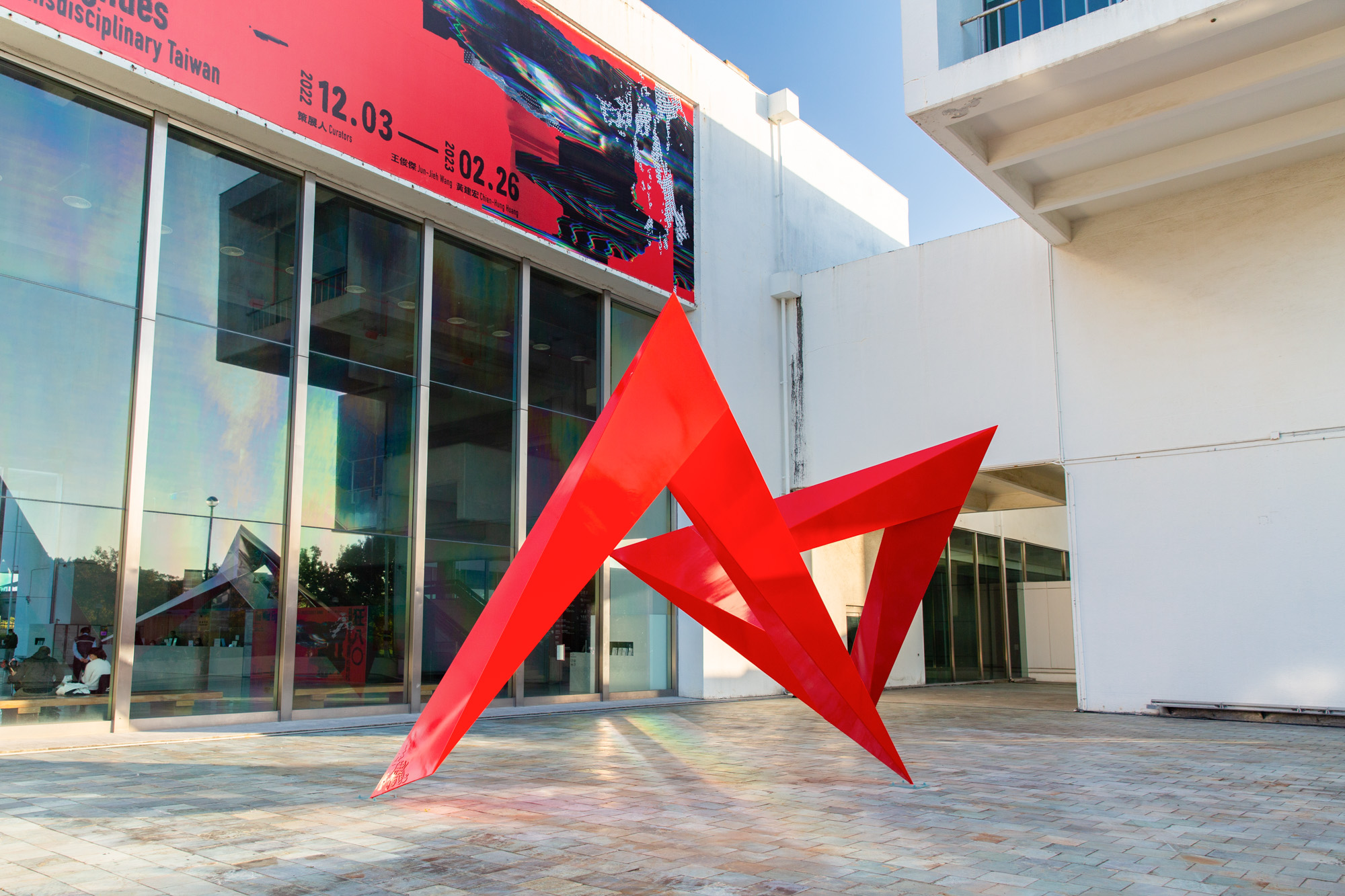Taipei: The Wild Eighties
By Annette An-Jen Liu
Full text also available in Chinese.

Installation view of LEE TSAI-CHIEN’s Finite to Infinite, 1983, stainless steel, color coating, 5 × 5 × 10m, at "The Wild Eighties: Dawn of a Transdisciplinary Taiwan," Taipei Fine Arts Museum (TFAM), 2022-23. Courtesy TFAM.
“The Wild Eighties”
Taipei Fine Arts Museum
After Taiwan’s severance of diplomatic ties with the United States in 1979, the 1980s was a transformative and liberating time for the island-nation, defining Taiwan’s sense of—and search for—identity. As martial law lifted in 1987 after 38 years, the economic boom with a rising middle class informed a new era of cultural development.
Leaning into this history, “The Wild Eighties: Dawn of a Transdisciplinary Taiwan” at the Taipei Fine Arts Museum (TFAM) was a large-scale exhibition that contextualized the emergence of the country’s avant-garde in art, literature, cinema, music, and theater. Curated by TFAM’s director Jun-Jieh Wang and Kuandu Museum of Fine Arts’ director Chien-Hung Huang, the exhibition sought to visualize its extensive research of tracing notable, concurring events and experiments across social sectors in Taiwan through an archival approach, relying heavily on reproduced documents, images, and records across its five thematic sections.
The first section, “Avant- Garde and Experimental,” began with introducing publications from the 1970s, such as the influential Hsiung Shih (Lion) Art Monthly under the editor-in-chief Chiang Hsun who in 1978 broadened the journal’s scope to include contemporary culture. The literary timeline was paired with newspaper clippings, early catalogs, installation photos, and artworks from TFAM’s opening as Taiwan’s first contemporary art museum in 1983. Included in the display was Work 8411 (1983), an abstract triptych by Chen Hsing-Wan, which plays with the textures of its mixed media, layering heavy acrylic on watercolor collaged with paper cut-outs, cardboard, and wooden sticks. This section also restaged works from the “Xirang” group exhibition series (1986–99) held in abandoned buildings, featuring Kao Chung-Li’s jarring sculptural installation, À la recherche du temps perdu (In Search of Lost Time) (1988), of a contorted female body hanging from above, whose head rests on top of a soil-covered mirror on the floor. The obscure work, differing from Kao’s image- based practice, reflected the experimental nature of the artist-run shows.
While artists ventured into different modes of expression in the underground scene, the 1980s was still a tension-filled period when artistic production was policed and censored, as seen in the section “Politics and Taboo.” Beginning with Taiwanese singer-songwriter Lo Ta-you’s politically critical album Master of the Future (1983)—which was banned and had to be revised—the second gallery showcased photo documentation and clippings outlining the “Red Star Incident,” a controversy where artist Lee Tsai-Chien’s red, steel sculpture Finite to Infinite, installed at TFAM’s terrace in 1983, was repainted silver by the museum after a veteran complained that it resembled a communist five- pointed star from a certain angle. Public outrage at this “revision” helped restore the work to its original color in 1986, and the sculpture was reinstalled at its original site for “The Wild Eighties,” drawing a contrast with the current political relaxation under a democratic system.
These creative attempts contributed to the establishment of a “local consciousness” amid rapid globalization—an important and continuous effort considering Taiwan’s precarious geopolitics with mainland China. The chapter on “Local, Global, and Identity” spotlighted the Taiwanese Nativist art movement pioneered by self-taught painter Hung Tung and sculptor Ju Ming that emerged during this period. Hung’s undated Drawing Calligraphy XVIII is a vertical, embellished ink scroll painting of three figures in ambiguous traditional wear incorporating Taiwanese folklore and opera. Nearby, Ju’s life-size cedarwood Tai Chi (1980) sculpture depicted a boxy, geometric figure in a tai chi pose. Both works showcased Hung’s and Ju’s distinct visual language, one that was largely recognizable, with references that were familiar locally, propelling them to national recognition in the late 1970s and ’80s.
“The Wild Eighties” ambitiously offered an encyclopedic overview of a seminal decade in Taiwan’s history. The presentation of its archival approach, however, was easily overwhelming at times, and the broad topics restricted more in-depth discussions (albeit an international forum was organized to facilitate further exploration). Considering TFAM’s 40th anniversary this year, the exhibition contributed to the museum’s ongoing national mission to shape Taiwan’s contemporary history, with the prominent narrative of Taiwan’s sovereignty as a young and thriving democracy.
.jpg)






